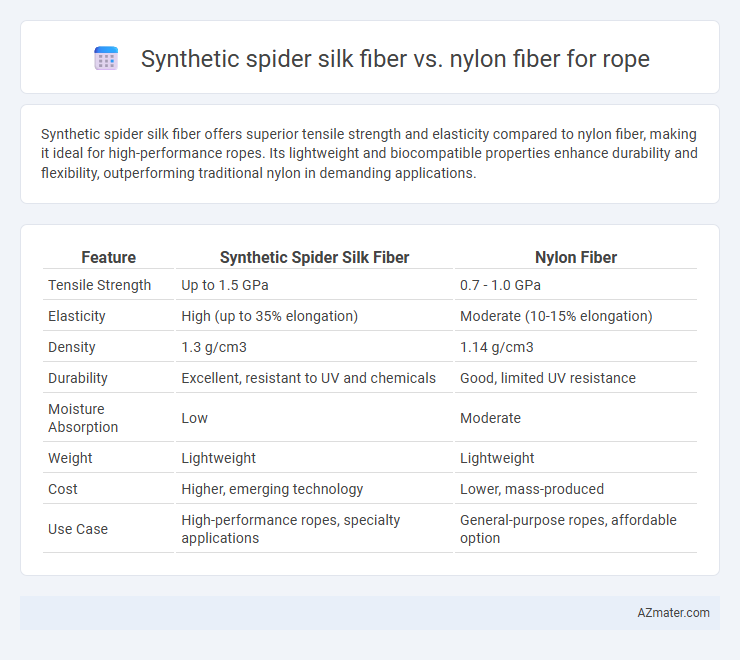Synthetic spider silk fiber offers superior tensile strength and elasticity compared to nylon fiber, making it ideal for high-performance ropes. Its lightweight and biocompatible properties enhance durability and flexibility, outperforming traditional nylon in demanding applications.
Table of Comparison
| Feature | Synthetic Spider Silk Fiber | Nylon Fiber |
|---|---|---|
| Tensile Strength | Up to 1.5 GPa | 0.7 - 1.0 GPa |
| Elasticity | High (up to 35% elongation) | Moderate (10-15% elongation) |
| Density | 1.3 g/cm3 | 1.14 g/cm3 |
| Durability | Excellent, resistant to UV and chemicals | Good, limited UV resistance |
| Moisture Absorption | Low | Moderate |
| Weight | Lightweight | Lightweight |
| Cost | Higher, emerging technology | Lower, mass-produced |
| Use Case | High-performance ropes, specialty applications | General-purpose ropes, affordable option |
Introduction: The Evolution of Rope Materials
Synthetic spider silk fiber exhibits exceptional strength-to-weight ratio and enhanced elasticity compared to traditional nylon fiber, making it a revolutionary material in rope manufacturing. Unlike nylon, which is derived from petrochemicals and prone to abrasion and UV degradation, synthetic spider silk offers superior durability and environmental sustainability due to its bioengineered protein composition. Advances in biotechnology now enable mass production of synthetic spider silk fibers, paving the way for ropes that combine lightweight flexibility with unmatched tensile strength and resilience.
What is Synthetic Spider Silk Fiber?
Synthetic spider silk fiber is a high-performance biomimetic material engineered to replicate the extraordinary strength, elasticity, and lightweight properties of natural spider silk. Unlike nylon fiber, which is a synthetic polymer primarily derived from petrochemicals, synthetic spider silk fibers are produced using bioengineered proteins that offer superior tensile strength and elasticity, making them ideal for advanced rope applications. This fiber's unique molecular structure results in ropes with enhanced durability, flexibility, and biodegradability compared to traditional nylon ropes.
Understanding Nylon Fiber: Properties and Uses
Nylon fiber, a synthetic polymer known for its exceptional tensile strength, elasticity, and abrasion resistance, is widely used in rope manufacturing due to its durability and flexibility under heavy loads. Its resistance to moisture, chemicals, and UV radiation makes nylon ropes ideal for marine, climbing, and industrial applications where robustness and reliability are critical. Compared to synthetic spider silk fiber, nylon is heavier and less environmentally sustainable but remains favored for cost-effective, high-performance rope solutions.
Mechanical Strength: Spider Silk vs. Nylon
Synthetic spider silk fiber exhibits superior mechanical strength compared to nylon fiber, offering tensile strength up to 1.6 GPa while nylon typically ranges between 0.6 to 0.9 GPa. Its exceptional strength-to-weight ratio and elasticity contribute to enhanced durability and resistance to wear in rope applications. These properties make synthetic spider silk fiber a promising alternative to nylon for high-performance, lightweight, and resilient ropes.
Durability and Environmental Resistance
Synthetic spider silk fiber exhibits superior durability compared to nylon fiber due to its high tensile strength and exceptional elasticity, allowing it to withstand greater stress and repeated loading without breaking. Environmental resistance of synthetic spider silk is enhanced by its natural biocompatibility and resistance to degradation from UV radiation, moisture, and temperature extremes, outperforming nylon fiber which tends to weaken and degrade under prolonged exposure to harsh environmental conditions. These properties make synthetic spider silk fiber an advanced material choice for ropes requiring long-lasting performance and sustainable durability.
Flexibility and Elasticity Comparison
Synthetic spider silk fiber exhibits superior flexibility and elasticity compared to nylon fiber, making it an ideal material for high-performance ropes. The exceptional stretchability of synthetic spider silk allows it to absorb more energy under tension without permanent deformation, enhancing durability and shock absorption. Nylon fiber, while flexible, has lower elasticity and tends to suffer from fatigue under repeated stress, reducing its lifespan in demanding applications.
Weight and Density Differences
Synthetic spider silk fiber boasts a significantly lower density, approximately 1.3 g/cm3, compared to nylon fiber's density of around 1.15 g/cm3, resulting in lighter yet stronger ropes. This lower weight-to-strength ratio allows synthetic spider silk ropes to maintain high tensile strength while reducing overall load, making them ideal for applications requiring lightweight durability. The superior strength-to-weight advantage of synthetic spider silk enhances performance in climbing, rescue, and aerospace rope systems.
Biodegradability and Environmental Impact
Synthetic spider silk fiber offers exceptional biodegradability compared to traditional nylon fiber, breaking down naturally without releasing harmful microplastics that pollute ecosystems. Its production requires less energy and generates fewer greenhouse gases, minimizing environmental footprints relative to petroleum-based nylon. Using synthetic spider silk for ropes contributes to sustainable material cycles and reduces plastic waste accumulation in marine and terrestrial habitats.
Production Methods and Scalability
Synthetic spider silk fiber is produced through biotechnological methods such as recombinant DNA technology, involving the expression of spider silk genes in host organisms like bacteria, yeast, or plants, enabling environmentally friendly and potentially renewable production. Nylon fiber, synthesized via chemical polymerization of caprolactam through ring-opening polymerization, benefits from well-established industrial-scale manufacturing with high scalability and consistent quality. While synthetic spider silk offers superior strength-to-weight ratio and biodegradability, its production currently faces challenges in scaling up cost-effectively compared to the mature, highly scalable nylon fiber industry widely used in rope manufacturing.
Future Perspectives: Which Fiber Leads Rope Innovation?
Synthetic spider silk fiber exhibits remarkable tensile strength, elasticity, and biodegradability, positioning it as a revolutionary material in rope innovation compared to traditional nylon fiber, which offers durability and affordability. Advancements in bioengineering and scalable production methods are expected to overcome current cost and manufacturing challenges of synthetic spider silk, potentially transforming industries reliant on high-performance ropes. The future of rope technology leans toward synthetic spider silk fibers due to their superior mechanical properties and environmental sustainability, driving innovation in applications demanding lightweight strength and ecological compatibility.

Infographic: Synthetic spider silk fiber vs Nylon fiber for Rope
 azmater.com
azmater.com